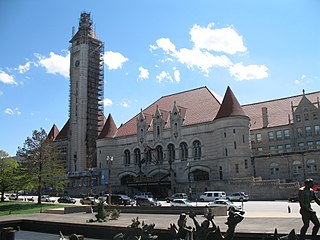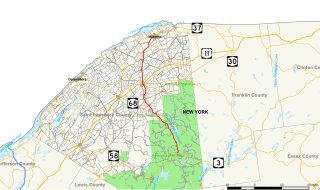Related Research Articles

Colton is a city in San Bernardino County, California, United States. Nicknamed "Hub City", it is located in the Inland Empire region of the state and is approximately 57 miles (92 km) east of Los Angeles. The population of Colton is 52,154 according to the 2010 census, up from 47,662 at the 2000 census.

The Kansas City Southern Railway Company, owned by Kansas City Southern (KCS) and founded in 1887, operates in 10 midwestern and southeastern U.S. states: Illinois, Missouri, Kansas, Oklahoma, Arkansas, Tennessee, Alabama, Mississippi, Louisiana and Texas. KCSR hauls freights for seven major government and business sectors: agriculture and minerals; military; automotive; chemical and petroleum; energy; industrial and consumer products; and intermodal.

The Atchison, Topeka and Santa Fe Railway, often referred to as the Santa Fe or AT&SF, was one of the larger railroads in the United States. Chartered in February 1859, the railroad reached the Kansas-Colorado border in 1873 and Pueblo, Colorado, in 1876. To create a demand for its services, the railroad set up real estate offices and sold farm land from the land grants that it was awarded by Congress. Despite the name, its main line never served Santa Fe, New Mexico, as the terrain was too difficult; the town ultimately was reached by a branch line from Lamy.

The Illinois Central Railroad, sometimes called the Main Line of Mid-America, was a railroad in the central United States, with its primary routes connecting Chicago, Illinois, with New Orleans, Louisiana, and Mobile, Alabama. A line also connected Chicago with Sioux City, Iowa (1870). There was a significant branch to Omaha, Nebraska (1899), west of Fort Dodge, Iowa, and another branch reaching Sioux Falls, South Dakota (1877), starting from Cherokee, Iowa. The Sioux Falls branch has been abandoned in its entirety.

In American railroading, a frog war occurs when a private railroad company attempts to cross the tracks of another, and this results in hostilities, with the courts usually getting involved, but often long after companies have taken the matter in their own hands and settled, with hordes of workers battling each other. It is named after the frog, the piece of track that allows the two tracks to join or cross and is usually part of a level junction or railroad switch.
The Alabama Southern Railroad is a class III railroad that operates in the southern United States. The ABS is one of several short line railroads owned by Watco Companies. The railroad operates an 85-mile (137 km) line leased from the Kansas City Southern Railway. It began operating in 2005.

The Chicago and Eastern Illinois Railroad was a Class I railroad that linked Chicago to southern Illinois, St. Louis, and Evansville. Founded in 1877, it grew aggressively and stayed relatively strong throughout the Great Depression and two World Wars before finally being purchased by the Missouri Pacific Railroad and the Louisville and Nashville Railroad (L&N). Missouri Pacific merged with the C&EI corporate entity in 1976, and was later acquired itself by the Union Pacific Railroad.

The Illinois Terminal Railroad Company, known as the Illinois Traction System until 1937, was a heavy duty interurban electric railroad with extensive passenger and freight business in central and southern Illinois from 1896 to 1982. When Depression era Illinois Traction was in financial distress and had to reorganize, the Illinois Terminal name was adopted to reflect the line's primary money making role as a freight interchange link to major steam railroads at its terminal ends, Peoria, Danville, and St. Louis. Interurban passenger service slowly was reduced, and it ended in 1956. Freight operation continued but was hobbled by tight street running in some towns requiring very sharp radius turns. In 1956, ITC was absorbed by a consortium of connecting railroads.

The Mobile and Ohio Railroad was a railroad in the Southern U.S. The M&O was chartered in January and February 1848 by the states of Alabama, Kentucky, Mississippi, and Tennessee. It was planned to span the distance between the seaport of Mobile, Alabama and the Ohio River near Cairo, Illinois. On September 13, 1940 it was merged with the Gulf, Mobile and Northern Railroad to form the Gulf, Mobile and Ohio Railroad.

The Terminal Railroad Association of St. Louis is a switching and terminal railroad that handles traffic in the St. Louis, Missouri, metropolitan area. It is co-owned by several Class I railroads that reach the city.

Colton Crossing is a railway crossing situated in Colton, California, directly south of Interstate 10. First built in 1883, it was the site of one of the most intense frog wars in railroad construction history, leading to a personal confrontation between famed lawman Virgil Earp and California Governor Robert Waterman. The crossing was the intersection of the tracks for the former ATSF and former Southern Pacific (SP) railroads. Southern Pacific is now Union Pacific and the Atchison, Topeka and Santa Fe Railway is now BNSF, and both the UP and BNSF still utilize their respective's predecessor's tracks. The Union Pacific tracks runs east-west at the crossing while the BNSF tracks operate north-south (both eventually head west to Los Angeles. Metrolink trains and Amtrak's Southwest Chief also use the BNSF tracks through the crossing while Amtrak's Sunset Limited utilize the UP tracks for that service. The Union Pacific tracks comes from the east through the Coachella Valley and into the yard in West Colton. On the other hand, the BNSF tracks from the south continues through the yard in San Bernardino and north to Cajon Pass and eventually Barstow.

James Cooksey Earp was a lesser known older brother of Old West lawman Virgil Earp and lawman/gambler Wyatt Earp. Unlike his brothers, he was a saloon-keeper and was not present at the Gunfight at the O.K. Corral on October 26, 1881.

The California Southern Railroad was a subsidiary railroad of the Atchison, Topeka and Santa Fe Railway in Southern California. It was organized July 10, 1880, and chartered on October 23, 1880, to build a rail connection between what has become the city of Barstow and San Diego, California.

The Tazewell & Peoria Railroad (T&P) is a short-line railroad, running entirely in Peoria County and Tazewell County, Illinois, and formed by Genesee & Wyoming Inc. to lease the assets of the century-old Peoria and Pekin Union Railway (P&PU), which is owned by Union Pacific, Norfolk Southern and Canadian National. It switches close to 100,000 cars per year and has about 142 miles of track.

New York State Route 56 (NY 56) is a north–south state highway in eastern St. Lawrence County, New York, in the United States. The southern terminus of the route is at an intersection with NY 3 in the town of Colton. Its northern terminus is at a junction with NY 37 southwest of Massena in the town of Louisville. NY 56 follows the Raquette River for most of its length and serves the village of Potsdam, where it passes by the campus of State University of New York at Potsdam.

The following is an alphabetical list of articles related to the U.S. state of Illinois.

The Chicago, Attica and Southern Railroad, nicknamed the "Dolly Varden Line", was a railroad linking small towns in west central and northwestern Indiana to the Chicago and Eastern Illinois Railway (C&EI) near Momence, Illinois. Never financially strong, the CA&S nevertheless continued operating through World War II before abandonment.

The Wabash Railroad was a Class I railroad that operated in the mid-central United States. It served a large area, including track in the states of Ohio, Indiana, Illinois, Iowa, Michigan, and Missouri and the province of Ontario. Its primary connections included Chicago, Illinois; Kansas City, Missouri; Detroit, Michigan; Buffalo, New York; St. Louis, Missouri; and Toledo, Ohio.

Joseph Hutchins Colton, known professionally as J.H. Colton, founded an American mapmaking company which was an international leader in the map publishing industry between 1831 and 1890.
References
- ↑ Colton, G. Woolworth. "G. Woolworth Colton's railroad map of Illinois". Library of Congress . Retrieved 2016-06-03.
| This United States rail–related article is a stub. You can help Wikipedia by expanding it. |